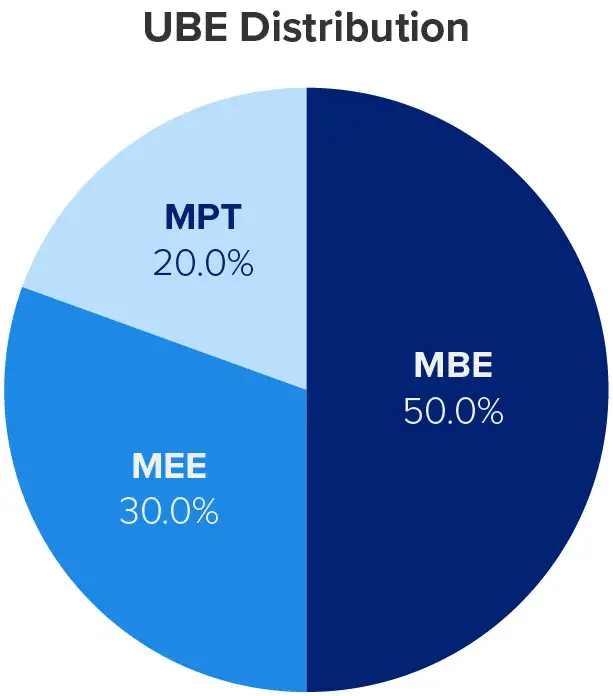The bar exam’s format, subjects, and topics are largely consistent across jurisdictions, with the majority having adopted the Uniform Bar Exam (UBE). Some non-UBE states, however, incorporate state-specific subjects while still using 1 or more UBE components. Starting in 2026, the NextGen Bar Exam will introduce additional changes to the exam’s structure in participating jurisdictions.
Let’s break down the current UBE format, its core components, how non-UBE states differ, and what to expect from the upcoming NextGen Bar Exam.
UBE® Format
The UBE is administered over 2 days and tests legal knowledge and practical skills through 3 components:
- Multistate Bar Examination (MBE®)
- Multistate Essay Examination (MEE®)
- Multistate Performance Test (MPT®)
Day 1 includes 2 MPT tasks in the morning and 6 essay questions in the afternoon, while day 2 is devoted to the MBE, with 100 multiple-choice questions in the morning and afternoon sessions.
| UBE Structure | ||
|---|---|---|
| Session | Tuesday | Wednesday |
| Morning(3-hour session) | 2 MPTs | 100 MBE multiple-choice questions |
| Afternoon(3-hour session) | 6 essay questions | 100 MBE multiple-choice questions |
MEE
The MEE consists of 6 essay questions to be completed in 3 hours, each presenting hypothetical scenarios that test a range of legal topics. Some questions may focus on a single subject, while others combine multiple subjects, requiring you to address complex, overlapping legal issues.
Not all subjects are tested each year, and some topics may be omitted or combined. This variability means you must be ready to tackle a wide range of topics, quickly identify key issues, and apply legal rules effectively. Clear, concise, and well-organized analysis is essential for success.
Learn More
MPT
The MPT includes two 90-minute tasks that simulate real-world legal work, such as drafting memos or letters. You’ll analyze provided materials — like case files and legal rules — and use them to complete real-world lawyering tasks in the fictional jurisdiction of “Franklin.”
No outside legal knowledge is required, and everything you need to complete tasks is provided. The MPT assesses your ability to apply facts to law, solve problems, and communicate effectively in writing, focusing on the skills necessary in everyday legal practice.
Learn More
MBE
The MBE is a 200-question multiple-choice exam divided into two 3-hour sessions. It presents hypothetical scenarios that test your ability to apply legal principles across various topics. Each question has 4 answer choices that challenge your understanding through tricky distractors.
The exam emphasizes analytical reasoning over rote memorization. Strong reasoning and careful analysis are key to doing well.
Learn More
UBE Subjects and Topics
The UBE tests a broad range of subjects to assess a candidate's grasp of fundamental legal principles and practical lawyering skills. The exam covers 12 subjects, which are divided between the MBE and the MEE. Some subjects are tested in both sections, while others are only tested on the MEE.
Below is a breakdown of the core subjects and key topics that may appear on the UBE.
| Subject | Key Subtopics | Brief Summary | Exam Section |
|---|---|---|---|
| Civil Procedure | Jurisdiction, pleadings, motions, pretrial procedure, trial procedure, judgments, appeals | Covers the rules governing civil litigation in federal courts | MBE, MEE |
| Constitutional Law | Federalism, separation of powers, individual rights, First Amendment | Focuses on the powers of the government and the rights of individuals under the Constitution | MBE, MEE |
| Contracts | Contract formation, defenses, breach, remedies, third-party rights | Governs the formation and enforcement of contracts, as well as remedies for breach | MBE, MEE |
| Criminal Law and Procedure | Crimes, inchoate offenses, defenses, constitutional protections for the accused | Covers substantive criminal law and the procedural protections of the accused | MBE, MEE |
| Evidence | Relevance, hearsay, privileges, burdens of proof, admissibility | Deals with the admissibility of evidence in trials and legal proceedings | MBE, MEE |
| Real Property | Ownership, rights in land, landlord-tenant law, mortgages, property transfers | Covers issues related to property ownership, transfers, and land use | MBE, MEE |
| Torts | Negligence, intentional torts, strict liability, product liability, defenses | Governs liability for harm caused by 1 party to another, whether intentional or through negligence | MBE, MEE |
| Business Associations | Corporations, partnerships, LLCs, fiduciary duties, agency | Addresses the structure and governance of business entities, including corporations and partnerships | MEE |
| Conflict of Laws | Choice of law, recognition of judgments, jurisdictional issues | Addresses issues arising from differences in laws between jurisdictions | MEE |
| Family Law | Marriage, divorce, child custody, adoption, support | Covers the legal aspects of marriage, divorce, and parental rights | MEE |
| Trusts and Estates | Wills, intestacy, trusts, fiduciary duties of trustees | Covers the transfer of property upon death and the administration of trusts | MEE |
| Secured Transactions | Creation, perfection, priority of security interests under Article 9 UCC | Covers secured transactions in personal property, focusing on creditor rights | MEE |
UBE Component Weight and Distribution
The UBE’s weight distribution — 50% MBE, 30% MEE, and 20% MPT — balances legal knowledge with practical skills. Since the MBE makes up half of your score, strong performance here can offset weaker results on the MEE or MPT.
Conversely, a low MBE score requires higher MEE and MPT scores to compensate. The MBE is also scaled, meaning scores are adjusted based on how others perform, adding some variability.
Learn More
Non-UBE States Bar Exam Format, Subjects, and Topics
While most jurisdictions have adopted the UBE, some states continue to administer their own unique bar exams. These non-UBE states often include state-specific components alongside UBE components. For example:
- California tests state-specific subjects such as Community Property, in addition to the MBE.
- Louisiana focuses on Civil Law rather than Common Law, reflecting its French and Spanish legal traditions.
- Delaware emphasizes Business and Corporate Law due to the state’s prominence in corporate litigation.
Select a non-UBE state below for more information:
| Non-UBE States | ||
|---|---|---|
| California | Delaware | Florida |
| Guam | Georgia | Hawaii |
| Louisiana | Mississippi | Nevada |
| Northern Mariana Islands | Palau | Puerto Rico |
| South Dakota | Virginia | Wisconsin |
NextGen Bar Exam Format, Subjects, and Topics
The NextGen Bar Exam introduces major changes to better assess practical skills and integrated legal knowledge. Here's a brief overview of key differences from the UBE:
- Format: Unlike the UBE's separate components, the NextGen exam blends multiple-choice questions, essays, and practical tasks into a single, integrated format. This unified structure mirrors real-world legal practice by testing knowledge and skills together rather than isolating them.
- Foundational Concepts and Principles: The NextGen exam reduces the number of subjects from 14 to 8, focusing on broader, more essential legal principles. This shift ensures that the exam tests deeper knowledge in areas most relevant to entry-level practice, unlike the UBE’s broader but more fragmented approach.
Foundational Skills: The NextGen exam emphasizes practical skills such as client counseling, negotiation, and legal analysis, which are integrated with legal topics. This is a shift from the UBE, which focused more on memorization. The change ensures that candidates are better prepared for real-world legal tasks.
Learn more about the NextGen Bar Exam, including details on the foundational concepts, principles, and skills tested, which jurisdictions are adopting the new exam, and how to prepare.
Frequently Asked Questions
Do I need to take a state-specific exam?
Some non-UBE states administer a state-specific essay exam. Select the appropriate state page for details.
How many subjects are covered on the bar exam?
How many questions are on the bar exam?
What is Bar Reciprocity?
Bar reciprocity allows lawyers to practice in other states without retaking the bar, depending on state agreements.




